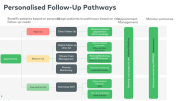As hybrid working gathers pace in many industries, the widespread adoption of more flexible working patterns in healthcare isn’t going to be easy. Drawing on years of experience deploying technologies to some of the world’s leading businesses, Keith Ali, MD at Creative ITC, explains how to overcome 5 common challenges when deploying remote working solutions to ensure healthcare organisations realise the full benefits.
Although workplace restrictions have eased under recent Living with COVID guidance, the higher risk nature of healthcare settings means employees in these environments have seen little change. Wary of continued outbreaks, many healthcare providers are still operating shifts, keeping vital care staff in separate teams to maintain continuity of service.
The impact on healthcare organisations is huge. Productivity has been affected as many cannot access hospital systems from home. Providers are also being hit financially – some must pay staff in full if they cannot attend their workplace as a result of public health advice.
Overcoming obstacles
To address these issues, the NHS is among many organisations setting a goal to enable all staff “to work flexibly, regardless of role, grade, reason or circumstance” in an effort to become “a more flexible, modern employer in line with other sectors”. In many industries, digital transformation has been the answer. The accelerated adoption of virtual desktop infrastructure (VDI) during the coronavirus pandemic is now facilitating long-term hybrid working.
However, many healthcare organisations have struggled to deploy VDI successfully for all staff, because off-the-shelf VDI platforms weren’t designed for power users working with graphics-heavy medical imaging applications, for example. Medical professionals, such as radiologists, have been effectively shackled to their IT set up on hospital premises in order to do their jobs.
Even before the coronavirus pandemic, IT teams in the healthcare sector faced mounting challenges to improve collaboration across multi-disciplinary teams in disparate locations. Data privacy, security and the demands of specialist medical applications have also created ever-growing demands on on-premise IT infrastructure and resources.
So, can IT teams in healthcare actually achieve what has been deemed impossible? Is unshackling power users from hospital premises achievable, without a hindered user experience damaging productivity? Can one deploy a sustainable, scalable solution that improves collaboration without introducing unnecessary cost and complexity?
The answer to all these questions is yes.
5 common VDI pitfalls and how to overcome them
Here are the five top reasons VDI projects have failed for healthcare organisations, and how to overcome them.
-
Poor user experience (UX)
Nothing can stop a VDI project in its tracks like substandard UX. If staff can’t easily share large files to collaborate in real time, decision-making will be delayed and frustration arise.
VDI in the right hands can be engineered for the most demanding of settings, including those working with graphics-heavy clinical imaging applications, as well as knowledge workers with basic IT needs. Purpose-built VDI solutions give users tools and experiences identical to or better than they enjoy in the workplace. Look for a supplier with a successful track record of designing and deploying remote working technologies in the healthcare sector. Their experience will be invaluable in unlocking full VDI potential.
-
Security and compliance issues
The transition to remote working has increased complexity of IT infrastructure and opened many organisations up to greater risk. Home laptops are susceptible to a wide range of attacks and security issues and it can be hard to ensure compliance.
IT teams need the freedom to decide which workloads to deploy in the cloud and which to retain on-premise. To optimise ROI, look for a provider who understands how to meet healthcare compliance requirements and offers VDI consumption in the cloud, on-premise, or using a hybrid model in a single seamless solution.
-
Internal resources
Be honest about your in-house skillset, resources available to manage long-term VDI deployment and legacy infrastructure. The managed service provider (MSP) route can quickly pay back with savings on data centre space, infrastructure, upgrades, licensing, application deployment, support, and headcount. Scrutinise their technical credentials and be confident they can deploy the right solution, leverage the latest technologies and provide ongoing management, optimisation and 24/7 support.
-
Unrealistic financial expectations
Beware of providers offering VDI solutions designed solely to save money. Before and after IT infrastructure costs can remain flat or even rise slightly. A more realistic approach is to build support based on a specialist provider’s ability to unlock much greater value for around the same outlay.
Check that cost comparisons are like-for-like. Start by calculating the total cost of ownership (TCO), usually over a five-year period. In-house expenses should include hardware refreshes, virtualisation software and additional GPU, together with costs associated with system administrator salaries, power, rack space, out-of-hours staffing and training costs to support the deployment. To reduce TCO further seek a provider that differentiates between VDI profiles for ordinary and power users and offers scalable pricing and burst capability.
-
Don’t ignore powerful workforce benefits
The value of enabling medical teams to work and collaborate effectively from anywhere should not be underestimated. Done well, it can expedite diagnoses and treatments resulting in improved patient outcomes.
Flexible working for all also has the potential to free healthcare staff from traditional workplaces and restrictive hours, avoiding delays to vital decision-making. For organisations, it offers the opportunity to retain existing people and attract new talent, contributing to mental health, wellbeing and engagement.
Medical-grade VDI in action
The award-winning VDI deployment for Worcestershire Acute Hospitals NHS Trust is a good example of a healthcare organisation unlocking the benefits of remote working through purpose-built technology.
The radiology department carries out over 384,000 diagnostic scans and x-rays annually. The Trust had sought ways to improve workforce mobility and collaboration. It had evaluated various VDI platforms, but affordable options were simply not up to the job.
Purpose-built, VDIPOD from Creative ITC means radiologists can now work effectively remotely with secure access to high quality medical imaging and healthcare systems. Freed from the hospital campus, they enjoy superior user performance and enhanced welfare. Working at home feels the same as on-site, with no loss of performance or speed.
As part of the managed service, Creative ITC provides 24-hour technical assistance, so radiologists can change work schedules or respond to an emergency. In addition to improved patient care the Trust believes its effective flexible working solution will help attract and retain the best specialists.
In the right hands, VDI solutions can be purpose-built using best-of-breed technologies for the most demanding of healthcare users, meaning all staff can benefit from flexible working. Even power users can effortlessly access heavy-graphics apps, control data and exchange large files – at home, in the office, or on the move.
It’s easy to look at any IT investment based purely on financial costs, but this ignores a host of wider benefits. Taking a holistic approach to VDI investment will result in a compelling case demonstrating clear ROI, enabling your healthcare organisation to not only enable remote and hybrid working, but actually to leverage it.





